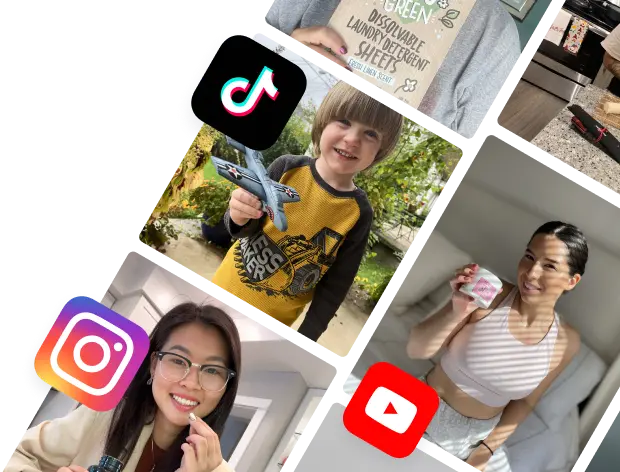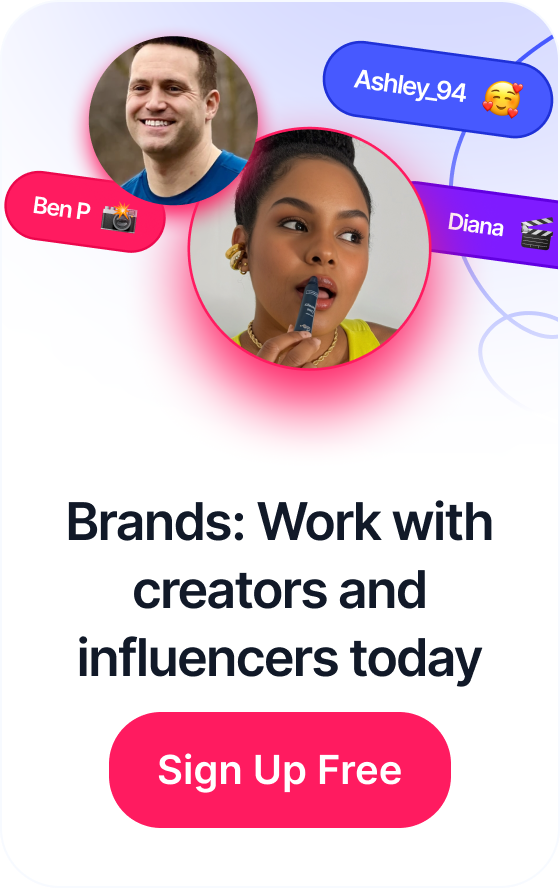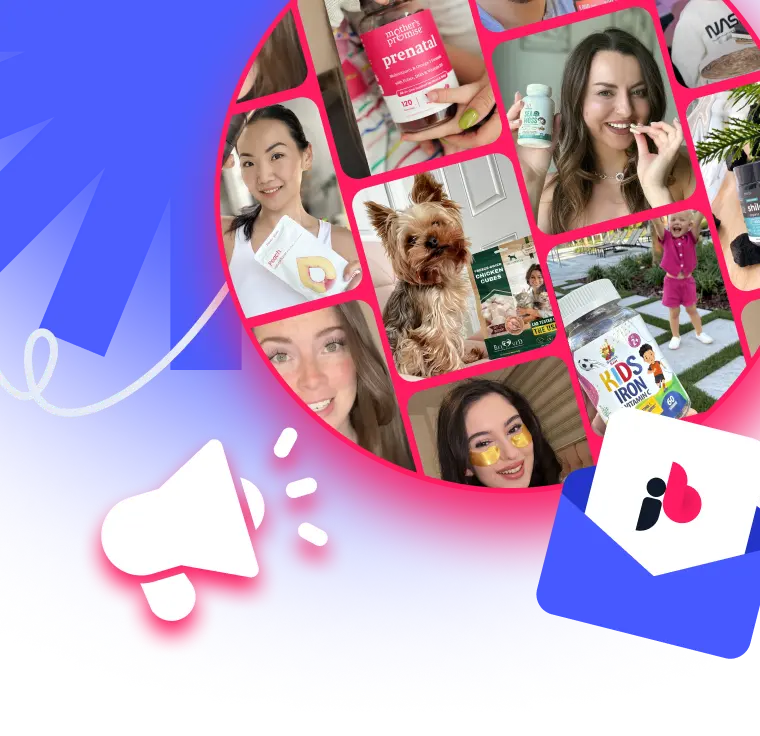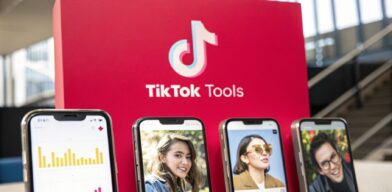 2025 List of TikTok Influencers: Top 7 Tools to Find Them
2025 List of TikTok Influencers: Top 7 Tools to Find Them
In an era where consumers crave authenticity over polished ads, user-generated content (UGC) has become the cornerstone of modern marketing. It’s the digital equivalent of word-of-mouth, offering genuine social proof that builds trust and drives purchasing decisions like no other strategy can. While UGC can be a key component in breakout successes, as seen in many viral marketing campaign examples, its true power lies in its consistent ability to foster a loyal community and provide a steady stream of credible content.
This article moves beyond the basics to showcase real-world user-generated content examples from leading brands that have mastered this approach. We will dissect what makes these campaigns successful, providing you with a strategic blueprint to inspire, manage, and scale your own UGC initiatives.
You will learn how to:
- Identify and encourage high-quality customer submissions.
- Analyze the specific tactics that drive campaign success.
- Apply these insights directly to your own marketing efforts.
Whether you're looking to boost engagement, gather authentic testimonials, or drive sales, these examples offer actionable lessons to harness the power of your most valuable asset: your customers. Let's explore the campaigns that are setting the standard for authentic brand-building.
Table of Contents
1. Product Reviews and Testimonials
Product reviews and testimonials are a foundational form of user-generated content, consisting of authentic assessments created by customers who have purchased and used a product or service. This content, whether written, video, or image-based, provides invaluable social proof that builds trust and helps potential buyers make informed decisions.

These authentic endorsements directly address a core consumer need: validation from peers, not just the brand. By showcasing real-world experiences, reviews offer a transparent look at an item's quality, performance, and value, making them a crucial asset for any e-commerce strategy.
Strategic Analysis
Amazon’s review system is a masterclass in leveraging user-generated content examples at scale. Its "Verified Purchase" tag immediately adds a layer of credibility, distinguishing reviews from paid or inauthentic feedback. Furthermore, Amazon encourages multi-format reviews, including photos and videos, allowing customers to show the product in a real-life context. This visual evidence is often more compelling than a brand's professionally shot product photos.
Sephora's Beauty Insider Community takes this a step further by integrating reviews into a community-driven platform. Customers can filter reviews by specific attributes like skin type, age, or eye color, making the feedback highly relevant and personalized. This targeted approach helps shoppers find opinions from people just like them, dramatically increasing the review's utility and impact.
Actionable Takeaways
Implementing a successful review strategy requires a proactive, structured approach. Brands can replicate this success by focusing on three key areas: acquisition, management, and leverage.
- Simplify the Submission Process: Reduce friction by enabling reviews directly on product pages and sending post-purchase emails with a direct link to leave a review. Avoid multi-step, complex forms.
- Incentivize (But Don't Mandate) Reviews: Offer small rewards like loyalty points or entry into a giveaway for leaving an honest review. This encourages participation without compromising authenticity.
- Engage with All Feedback: Respond publicly and professionally to both positive and negative reviews. A thoughtful response to criticism demonstrates that you value customer feedback and are committed to improvement.
- Showcase Reviews Prominently: Embed star ratings and top reviews directly on product pages, category pages, and even in marketing materials to maximize their impact on conversion rates.
2. Social Media Hashtag Campaigns
Social media hashtag campaigns are marketing initiatives that encourage users to create and share content using a specific, branded hashtag. These powerful campaigns tap into user creativity to generate a massive volume of authentic content, organically boosting brand visibility and engagement across platforms like Instagram, TikTok, and X (formerly Twitter).
By providing a simple call to action, brands can transform their audience from passive viewers into active brand advocates. This strategy fosters a sense of community and allows a brand’s message to spread far beyond its own followers, driven entirely by genuine user participation.
Strategic Analysis
Coca-Cola's #ShareACoke campaign is a legendary example of this strategy. By printing popular names on its bottles and encouraging people to find and share photos with their personalized Coke, the brand created an irresistible, personal connection. This simple but brilliant concept generated millions of posts, turning the product itself into a shareable social media prop.
Similarly, Starbucks’ annual #RedCupContest turns a seasonal product into a massive user-generated content engine. It encourages customers to decorate and photograph their holiday-themed cups, transforming a routine purchase into a creative competition. The best photos are featured on Starbucks' official channels, providing powerful social proof and a compelling reason for others to join in.
Actionable Takeaways
Launching a successful hashtag campaign requires a blend of creative strategy and logistical management. Brands can emulate this success by focusing on a few core principles to drive participation and achieve marketing goals.
- Create a Unique and Memorable Hashtag: It should be short, easy to spell, and directly related to your brand or campaign. Avoid generic terms that are already in wide use.
- Provide a Clear (But Flexible) Call to Action: Tell users exactly what kind of content to create, but give them enough creative freedom to make it their own. The best campaigns provide a theme, not a rigid script.
- Promote and Feature Submissions: Actively promote the campaign across all your marketing channels and regularly feature the best user submissions on your official social media profiles. This recognition is a powerful motivator.
- Engage and Monitor: Like, comment on, and share user posts to show appreciation and foster a community feel. For large-scale campaigns, leveraging various social media automation tools can significantly streamline the process of monitoring hashtags and engaging with user-generated content.
3. User-Generated Video Content
User-generated video content consists of videos created by customers, fans, or community members that feature a brand's products, services, or experiences. With the explosion of short-form video platforms like TikTok and Instagram Reels, this format has become one of the most powerful and engaging user-generated content examples available to brands.
These authentic videos capture genuine enthusiasm and creativity, offering a dynamic form of social proof that resonates deeply with modern audiences. From unboxing experiences and product tutorials to creative challenges, user-made videos provide a raw, trustworthy perspective that professionally produced ads often cannot match.
Strategic Analysis
Chipotle's #GuacDance challenge on TikTok is a prime example of successfully harnessing user-generated video at a massive scale. By tapping into a popular meme and creating a simple, branded dance, Chipotle inspired hundreds of thousands of users to create and share their own videos. The campaign became TikTok's highest-performing branded challenge in the U.S. at the time, driving significant brand awareness and engagement.
Similarly, GoPro has built its entire marketing ethos around user-shot footage. The brand encourages its users to submit their most stunning, action-packed videos captured on GoPro cameras. By curating and featuring the best of this content on their social channels and in commercials, GoPro transforms its customers into its most effective and authentic storytellers, showcasing the product's capabilities in the most compelling way possible.
Actionable Takeaways
Launching a successful user-generated video campaign requires a blend of clear direction and creative freedom. Brands can foster a vibrant video community by focusing on a few core strategies to encourage participation and maximize impact.
- Create Simple, Replicable Challenges: Design campaigns around a clear, easy-to-follow prompt or template, like a specific dance, sound, or creative filter. This lowers the barrier to entry and encourages mass participation.
- Provide Clear Brand Guidelines: Offer simple rules and hashtag suggestions to ensure content remains on-brand, but avoid overly restrictive creative briefs that stifle authenticity.
- Incentivize High-Quality Submissions: Reward standout creators with prizes, features on your official channels, or exclusive perks. This motivates users to put more effort into their content.
- Secure Content Usage Rights: Clearly state in your campaign terms how you plan to use submitted content. Always obtain explicit permission before repurposing user videos in official advertisements or on other marketing platforms.
4. Photo Contests and Visual Challenges
Photo contests and visual challenges are powerful user-generated content examples that incentivize customers to create and share original images based on a specific brand theme, product, or experience. These competitions tap into users' creative spirit, generating a high volume of authentic, high-quality visual assets while simultaneously boosting engagement and fostering a strong sense of community.
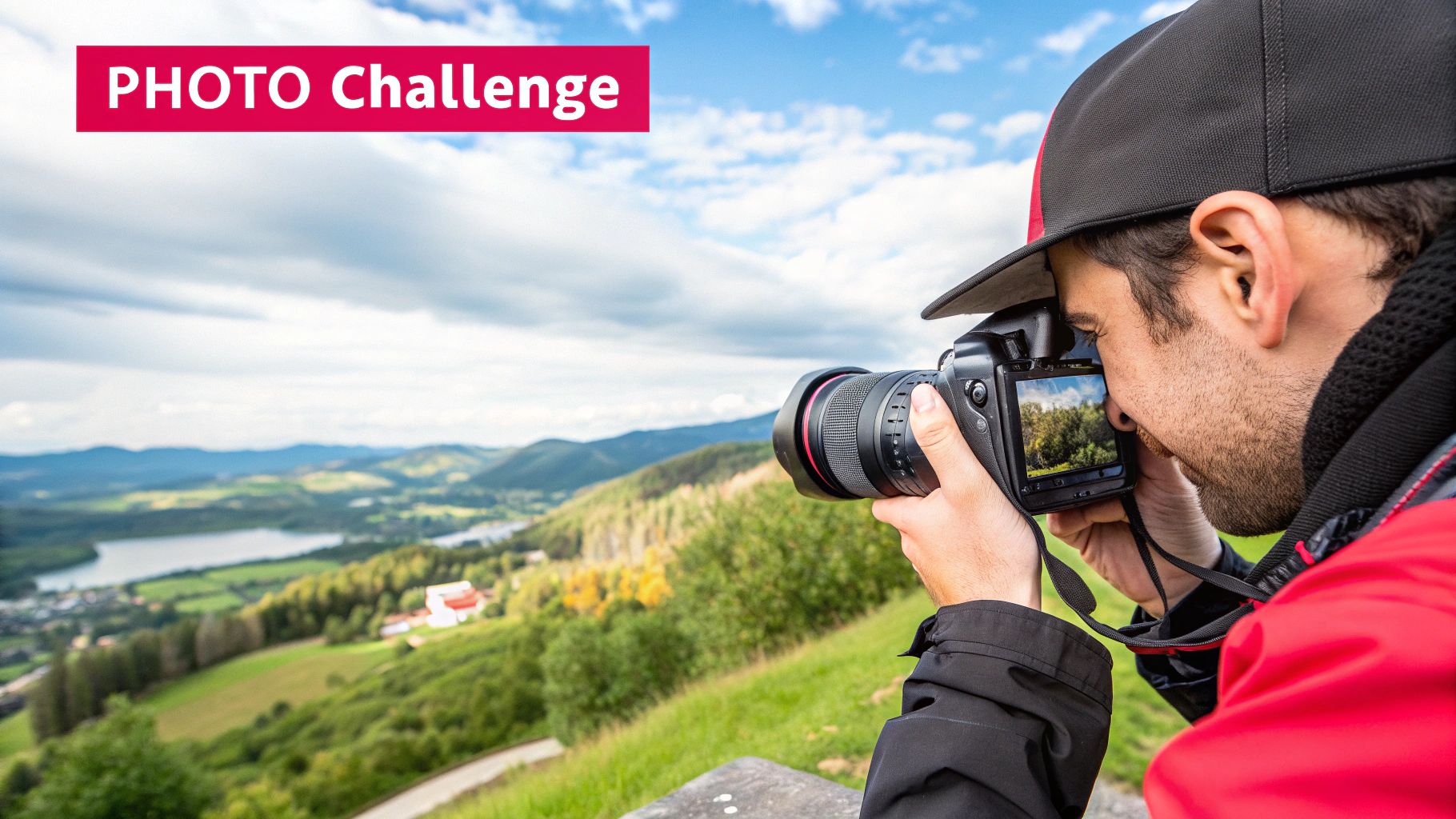
By gamifying the content creation process, brands can transform their audience from passive consumers into active brand advocates. These campaigns not only populate social media feeds with relevant imagery but also build an emotional connection as participants invest their time and creativity into the brand's narrative.
Strategic Analysis
National Geographic's annual photo contests are legendary, setting the gold standard for leveraging user creativity. By establishing prestigious themes and offering career-defining prizes, they attract breathtaking submissions from photographers worldwide. The contest serves as a massive content engine and reinforces their brand identity as the pinnacle of visual storytelling and exploration.
Adobe's Creative Challenges take a more product-focused approach. These regular contests prompt users to create art using specific Adobe software tools, often providing assets and tutorials. This strategy brilliantly showcases the software's capabilities through the community's work, providing social proof and inspiring potential users with tangible examples of what they can achieve. It's a direct, effective way to turn users into product champions.
Actionable Takeaways
To run a successful photo contest, brands must balance creative freedom with clear strategic goals. The key is to make participation exciting, accessible, and rewarding, which can be accomplished by focusing on several core actions.
- Define a Compelling Theme: Choose a theme that is broad enough for creativity but directly tied to your brand values or product usage. A travel company might run a #DestinationDreaming contest, while a coffee brand could use #MyMorningRitual.
- Offer Valuable Prizes: The prize should match the effort required. It could be a high-value product, a unique experience, or professional recognition. This directly motivates high-quality submissions.
- Establish Clear Guidelines: Create simple, easy-to-understand rules for submission, including necessary hashtags, tagging requirements, and deadlines. State clearly how you plan to use the submitted photos to ensure transparency.
- Promote Winners and Top Submissions: Showcase winning entries and a curated selection of top submissions on your website, social media channels, and email newsletters. This provides recognition to creators and inspires future participation.
5. Customer Success Stories and Case Studies
Customer success stories and case studies are in-depth narratives that showcase a customer's positive experience and tangible achievements with a product or service. This form of user-generated content moves beyond a simple review, detailing the customer's journey from their initial challenge to their ultimate triumph, positioning the brand as a critical enabler of that success.
These detailed accounts serve as powerful social proof, especially in B2B or high-consideration purchase environments. By framing the narrative around a relatable problem and a measurable solution, success stories provide a compelling, evidence-based argument that resonates deeply with prospective customers facing similar issues.
Strategic Analysis
Salesforce's customer stories are a prime example of leveraging this UGC format effectively. They transform client feedback into professionally produced case studies, complete with compelling narratives, high-quality visuals, and hard data. By featuring companies of various sizes and industries, they allow prospects to see a direct reflection of their own business challenges, making the solution feel more attainable and relevant.
HubSpot also excels in this area by not only publishing traditional case studies but also encouraging customers to share their growth stories on their own platforms. They often amplify these user-generated content examples through their social media channels, giving their customers exposure while simultaneously validating their product's impact. This creates a mutually beneficial relationship that fosters brand loyalty and advocacy.
Actionable Takeaways
Building a robust library of customer success stories requires a systematic process for identifying, capturing, and sharing these powerful narratives. Brands can replicate this success by focusing on structure and promotion.
- Create a Storytelling Template: Develop a consistent format that outlines the customer's background, the challenge they faced, the solution your product provided, and the specific, measurable results. This streamlines the collection process.
- Focus on Quantifiable Results: Prioritize stories that include concrete metrics like revenue growth, time saved, or efficiency improvements. Data-backed claims are significantly more persuasive than general praise.
- Make the Customer the Hero: Frame the narrative around the customer's journey and achievements. Your brand is the helpful guide, but the customer is the star who overcame the obstacle.
- Obtain Explicit Permissions: Always secure formal consent to use a customer's name, story, and any associated data in your marketing materials to ensure legal and ethical compliance.
6. Community Forums and Discussion Boards
Community forums and discussion boards are dedicated online spaces where users generate content by asking questions, providing answers, and sharing knowledge around a brand, product, or industry. These platforms cultivate peer-to-peer support and build a valuable, searchable repository of user-generated information that serves both customers and the brand itself.
This form of user-generated content transforms a brand’s website from a simple storefront into a dynamic hub for collaboration and problem-solving. By empowering users to help one another, companies can reduce support ticket volume, gain direct product feedback, and foster a deep sense of loyalty among their most engaged customers.
Strategic Analysis
Adobe's Experience League Community is a prime example of leveraging forums for complex B2B software. Users, ranging from beginners to experts, share detailed workflows, troubleshoot niche problems, and offer creative solutions. Adobe staff actively participate, answering questions and elevating top user contributions, which turns the forum into a trusted, official resource. This strategy positions their most passionate users as brand advocates and unofficial support agents.
Similarly, Reddit's brand-specific subreddits, like r/gopro or r/instantpot, function as massive, independent discussion boards. These communities thrive on organic user-generated content examples, from product hacks to troubleshooting threads. While not brand-owned, these forums provide unfiltered insights into consumer sentiment, common issues, and innovative product uses that savvy brands monitor closely.
Actionable Takeaways
Building a successful community forum requires a long-term commitment to moderation, engagement, and structure. Brands can cultivate a thriving discussion hub by implementing these core practices.
- Establish Clear Governance: Create and enforce transparent community guidelines from day one to ensure discussions remain constructive and on-topic. A well-moderated space feels safe and encourages participation.
- Recognize and Empower Superusers: Identify your most active and helpful community members. Reward them with special titles, early access to products, or direct lines of communication to show appreciation and encourage their continued leadership.
- Structure for Discoverability: Organize forums with clear categories, sub-forums, and tags. This makes it easy for users to find relevant conversations and prevents the same questions from being asked repeatedly.
- Integrate Community Insights: Actively monitor discussions for recurring issues, feature requests, and innovative ideas. Create a formal process to feed this valuable user-generated feedback directly to your product and marketing teams.
7. Brand Ambassador Programs
Brand ambassador programs are structured partnerships that formalize the relationship between a company and its most passionate advocates. This approach turns loyal customers and fans into an extension of the marketing team, empowering them to create authentic content and promote the brand within their personal networks. This strategy blends the raw authenticity of user-generated content with more guided, strategic messaging.

Unlike one-off influencer campaigns, these long-term collaborations foster a deeper connection, generating a consistent stream of high-quality content that feels both genuine and on-brand. By nurturing these relationships, companies cultivate a powerful, community-driven marketing engine.
Strategic Analysis
Lululemon's ambassador program is a prime example of integrating brand values with community leaders. By partnering with local yoga instructors and fitness trainers, the company doesn't just gain content; it embeds itself directly into the fitness communities it serves. These ambassadors provide authentic feedback on products and host local events, turning stores into community hubs and generating hyper-local user-generated content examples that resonate deeply with target audiences.
Similarly, Red Bull’s strategy of sponsoring extreme sports athletes goes beyond simple product placement. The brand empowers these athletes to create and share jaw-dropping content that perfectly embodies its "gives you wings" tagline. Red Bull acts as a media house, funding incredible feats and allowing its ambassadors the creative freedom to capture and share their experiences, resulting in some of the most compelling UGC in marketing history.
Actionable Takeaways
Building an effective brand ambassador program requires a focus on authentic relationships and mutual value, not just transactional exchanges. Brands can replicate this success by creating a structured yet flexible framework.
- Select for Passion, Not Just Reach: Prioritize genuine brand love and alignment over follower count. The most effective ambassadors are true fans who use and believe in your products.
- Provide Guidelines, Not Scripts: Offer clear brand guidelines and campaign goals but give ambassadors the creative freedom to produce content in their own unique voice. Authenticity is key.
- Offer Meaningful, Tiered Rewards: Go beyond free products. Create a tiered reward system that includes exclusive access to new releases, invitations to brand events, commissions on sales, and opportunities for co-creation.
- Ensure FTC Compliance: Be transparent about the partnership. Mandate that all ambassadors use clear disclosures like #ad or #sponsored in their posts to comply with FTC guidelines and maintain audience trust.
7 Key Examples of User-Generated Content
| Content Type | Implementation Complexity 🔄 | Resource Requirements ⚡ | Expected Outcomes 📊 | Ideal Use Cases 💡 | Key Advantages ⭐ |
|---|---|---|---|---|---|
| Product Reviews and Testimonials | Moderate – requires moderation and management | Low to moderate – mainly platform and moderation | Builds trust, improves SEO, higher conversions | E-commerce, service-based businesses | Authentic feedback, cost-effective, SEO boost |
| Social Media Hashtag Campaigns | Moderate – campaign design and ongoing engagement | Low – mainly creative development and social media management | High engagement, viral potential, brand visibility | Brand awareness, community building | Exponential reach, cost-effective content |
| User-Generated Video Content | Moderate to high – content curation and rights management | Moderate – incentivizing and moderating videos | High engagement, strong storytelling, viral potential | Brands targeting younger audiences, tutorials | Authentic storytelling, cost-effective, viral |
| Photo Contests and Visual Challenges | High – contest setup, moderation, judging, and legal management | Moderate to high – prizes, moderation, legal | High-quality content bank, increased engagement | Visual-heavy brands, marketing campaigns | High-quality visuals, community loyalty |
| Customer Success Stories and Case Studies | High – detailed development, approvals, production | High – interviews, production, legal approvals | Highly persuasive, credible, emotional impact | B2B, SaaS, health and transformation stories | Persuasive, detailed ROI proof |
| Community Forums and Discussion Boards | High – continuous moderation and community management | High – platform maintenance, moderators | Strong community, reduced support load, SEO content | Technical products, knowledge-sharing platforms | Valuable knowledge base, peer support |
| Brand Ambassador Programs | High – structured management, training, and tracking | High – rewards, training, ongoing coordination | Consistent quality content, deeper customer relationships | Lifestyle brands, fitness, beauty, outdoor | Authentic promotion, quality control, loyalty |
From Inspiration to Implementation: Activating Your UGC Strategy
The diverse array of user-generated content examples we've explored, from compelling product reviews to viral hashtag campaigns, all share a common thread: they harness the power of authentic customer voices to build trust and drive engagement. These campaigns are more than just marketing tactics; they represent a fundamental shift in how brands connect with their audiences, moving from one-way broadcasts to collaborative conversations. The success of these initiatives hinges on understanding that UGC is not just content you collect, but a community you cultivate.
The key takeaway is that the most impactful UGC strategies are intentional and well-structured. They don’t happen by accident. They are the result of brands clearly defining their goals, understanding their audience’s motivations, and creating a frictionless path for participation. Whether it's the raw honesty of a video testimonial or the creative energy of a photo contest, each format offers a unique way to tell your brand's story through the eyes of those who know it best.
Turning Insights into Actionable Strategy
Moving from inspiration to implementation requires a strategic framework. Your first step is to align a UGC format with a specific business objective. Are you trying to increase conversions on a product page? Prioritize customer reviews and video testimonials. Looking to boost brand awareness and social reach? A well-designed hashtag campaign is your best bet.
Once you have a goal, focus on these core principles:
- Clarity is Key: Your call to action must be simple, direct, and compelling. Users need to know exactly what you want them to create and why they should participate.
- Reduce Friction: Make the submission process as easy as possible. Complicated rules, lengthy forms, or technical barriers will kill momentum before it even starts.
- Provide Value: The incentive for creating content doesn't always have to be monetary. Recognition, community status, or the chance to be featured can be powerful motivators. For a deeper dive into what works, check out these tips to incentivize more user-generated content.
The Future is Co-Created
Ultimately, mastering user-generated content is about relinquishing a degree of creative control and trusting your community. By empowering your customers to become active storytellers, you unlock a sustainable, scalable, and incredibly persuasive marketing engine. The authenticity derived from these user-generated content examples is something no in-house marketing team can replicate on its own. It builds social proof, fosters loyalty, and creates a powerful feedback loop that can inform everything from product development to customer service.
Embrace the role of a facilitator rather than just a marketer. Provide the platform, set the stage, and then celebrate the creativity that your community brings to the table. By doing so, you transform passive consumers into passionate advocates, building a brand that is not just purchased, but truly beloved.
Ready to scale your UGC strategy and connect with thousands of vetted creators? JoinBrands provides the platform and AI-powered tools to manage campaigns, source high-quality authentic content, and drive real results, seamlessly. Explore JoinBrands to discover how you can activate your community and build your brand with powerful, on-demand UGC today.

